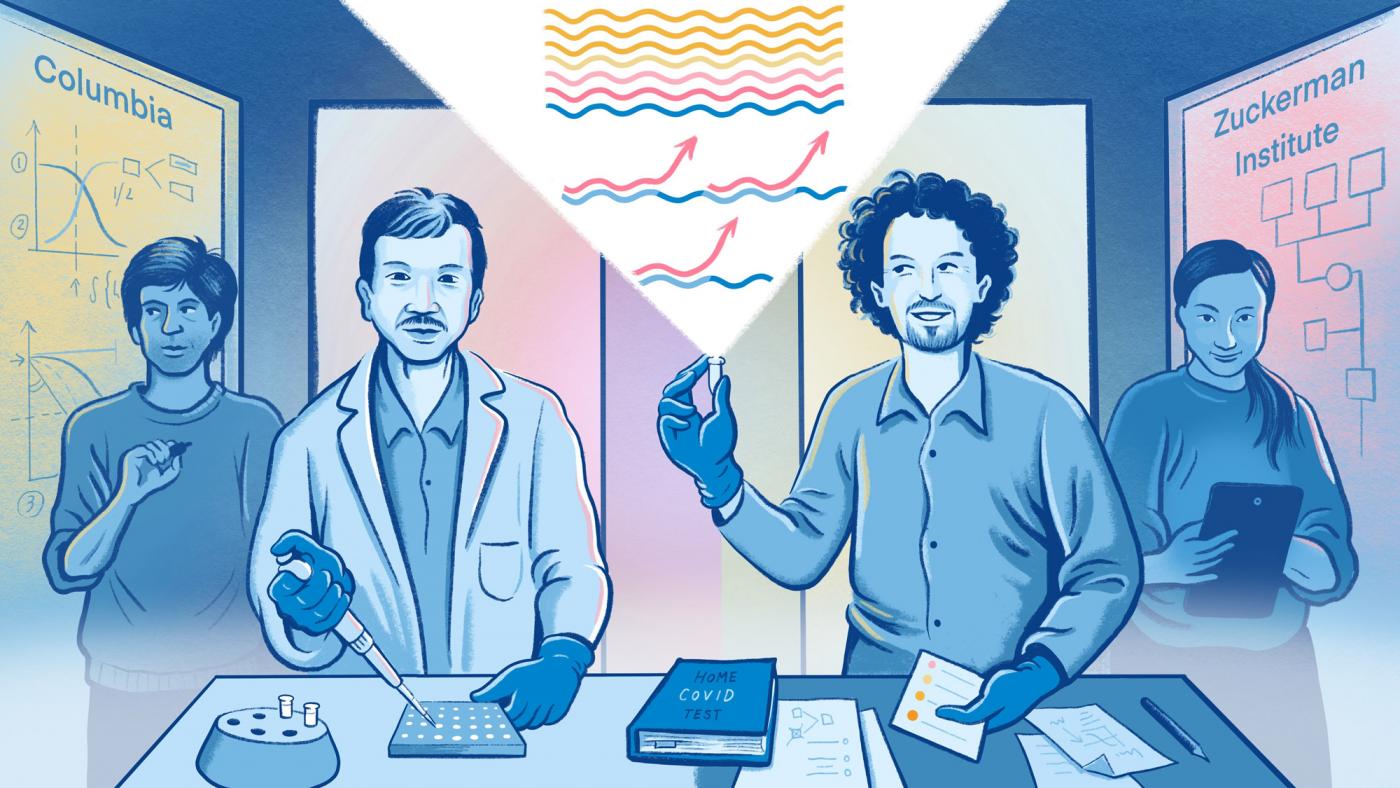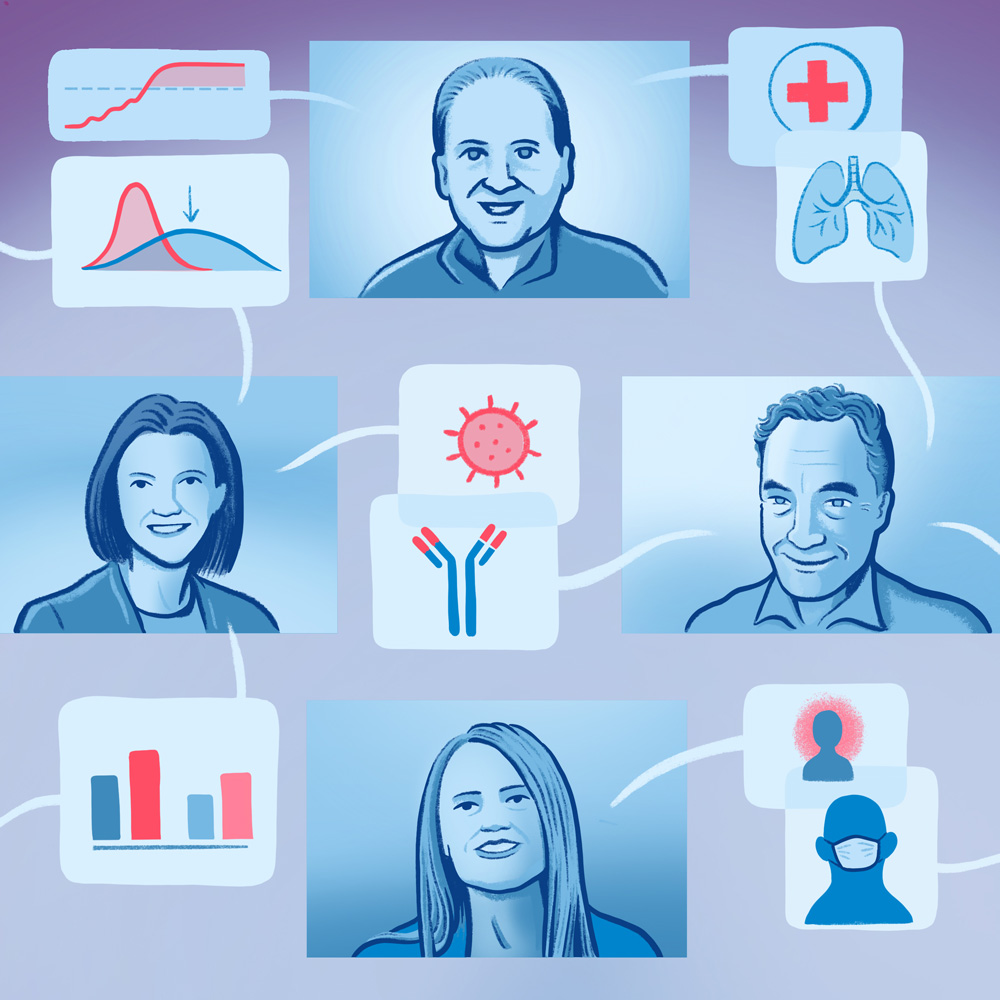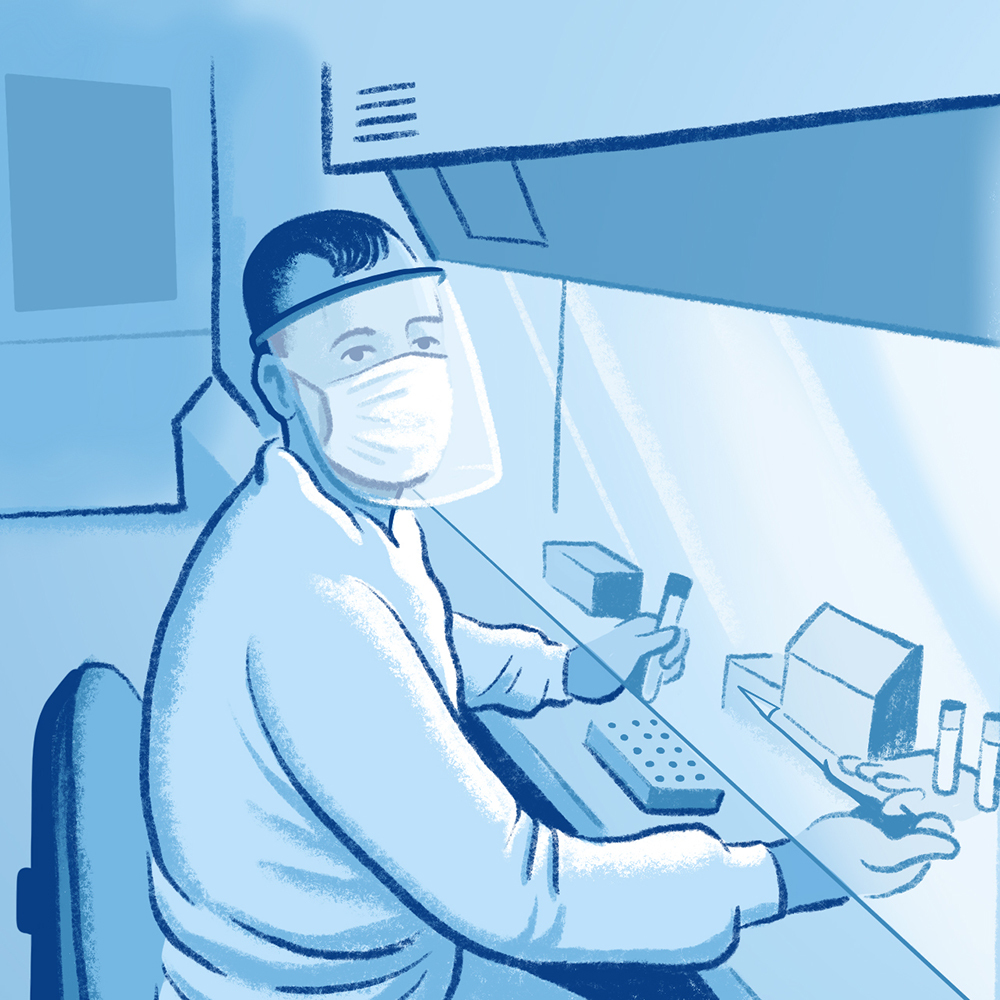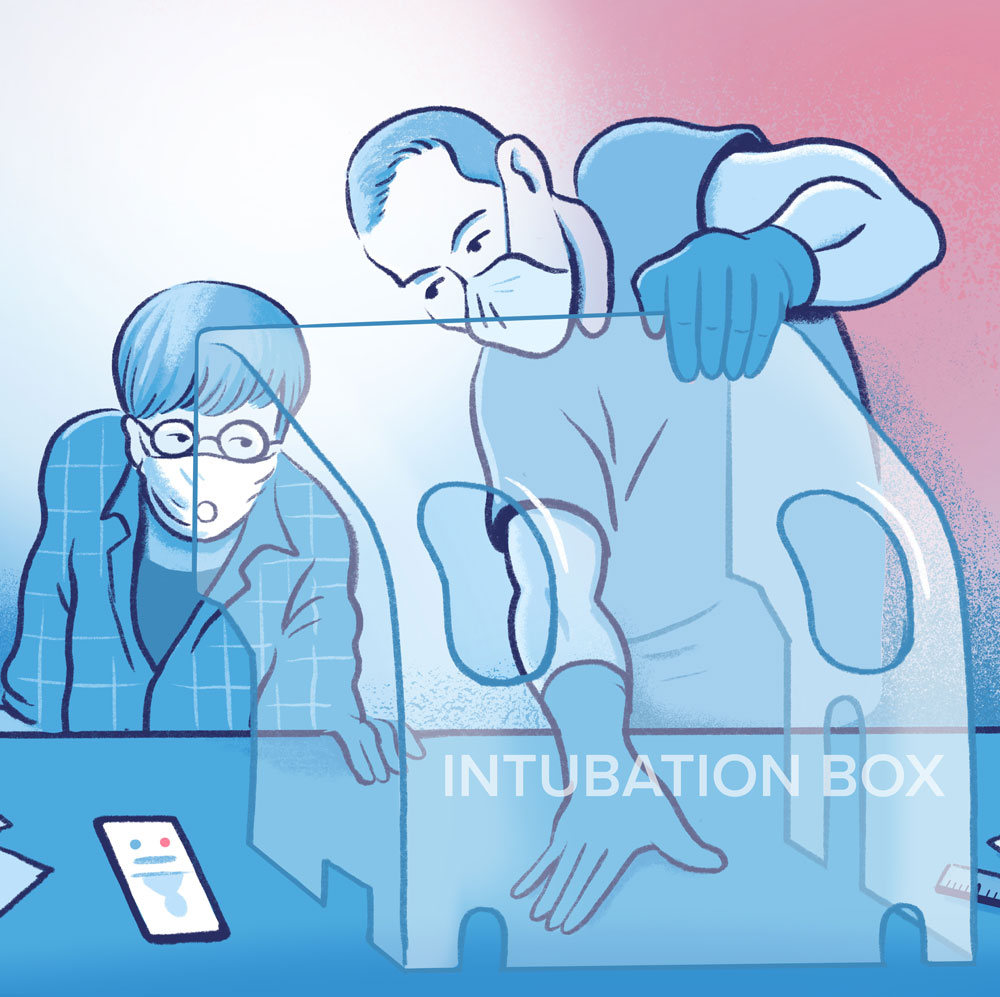KATHLEEN DURKIN I’m Kathleen Durkin of Columbia’s Zuckerman Institute.
DEVIN POWELL And I’m Devin Powell of the Zuckerman Institute.
KATHLEEN Welcome to Lab in the Time of Coronavirus. This podcast follows the lives of scientists at our Institute and at Columbia University who are pivoting to combat COVID-19 in this time of crisis.
DEVIN Throughout this crisis, we’ve been hearing a lot about COVID testing. We’ve been hearing a lot about the challenges involved in this testing. Tests can be hard to get. They are generally given only to symptomatic people, who are believed to have been exposed to the virus.
KATHLEEN The traditional nasal swab tests are uncomfortable. And at the risk of stating the obvious, the test results only tell you your status for that point in time. You could be exposed tomorrow or next week.
DEVIN Our story today starts with Marjorie Xie, a PhD candidate in the lab of Ashok Litwin-Kumar, PhD, principal investigator at Columbia’s Zuckerman Institute. Marjorie is part of a team that’s developing a testing strategy to address these problems: a new kind of test that could allow people to check themselves for COVID at home, without sending any samples into a lab.
We’re trying to design a test that’s so simple and cheap and efficient that people can test themselves every morning on their saliva to see if they’re contagious, and if they are, they will hopefully decide to stay home.
MARJORIE XIE A lot of cities are in a rush to emerge from lockdown, but it’s not met with the appropriate amount of testing to control the pandemic. Testing is important because right now only people who are symptomatic are observable and trackable. But studies show that if I am infected I will start shedding the virus two to three days before I show symptoms, and that I am most infectious a day before symptoms start to appear. So you might imagine that during this period I may have infected my friends, labmates, fellow subway users. So in order to control transmissions, we need to track infections before people show symptoms. And this is possible only through widespread testing on a daily basis. So when Andrés sent out a call for volunteers to help out with developing an at-home test, I felt like I needed to be there, so that’s why I’m here.
KATHLEEN Andrés is Andrés Bendesky, MD, PhD, a principal investigator at Columbia’s Zuckerman Institute. He usually studies social behavior, but after his lab ramped down because of the pandemic, he started looking for ways to help. He sent out an email seeking volunteers to develop a COVID test.
ANDRÉS BENDESKY We’re trying to design a test that’s so simple and cheap and efficient that people can test themselves every morning on their saliva to see if they’re contagious, and if they are, they will hopefully decide to stay home. We know on average one person transmits the virus, the disease, to three others. What if we were testing people weekly, how much can we decrease the transmission? What if we tested them twice a week? What if you could test them every single day? The sooner you catch it, the more you can stop the spread of the disease. I think it could be a game changer if everybody was testing themselves every morning.
DEVIN Many groups across the country are trying to develop home tests. At the time we recorded this, a group at Rutgers University had just come out with the first FDA-approved test that uses saliva. But this test still requires samples to be sent into a lab for analysis. So Andrés began assembling a team to create a way to check for COVID that can be done entirely from home. The test hasn’t yet been tried on people, but he’s optimistic.
ANDRÉS Recently people showed that saliva is actually more sensitive to detect the infection than those swabs at the back of the throat, and people have come up with assays that don’t require fancy equipment. So a few weeks ago we thought that the time was right to try to put together all of these advances of technologies to design a test that would work from home.
KATHLEEN We asked Andrés how the assay, the future home test, might be done.
ANDRÉS You will spit into a tube, take a drop from your saliva, mix it with a few other reagents into a tube, heat this reaction in small volumes in your kitchen for 30 to 40 minutes. After that time you will see if the reaction is pink or is yellow. And if it’s pink means you don’t have the virus, if it’s yellow you have the virus.
DEVIN So the test turns yellow if you have the virus and pink if you don’t. But what exactly is going on inside this test to make this happen. Let’s find out.
ANDRÉS When you want to detect an infectious disease or anything that has DNA or RNA, a virus or a bacteria, most methods require lots of DNA or RNA to detect it. Most of these methods require amplifying the DNA, making many copies and then detecting those many copies somehow. They take a swab from your nose, and then they extract the RNA, they convert the RNA into DNA and then they amplify it to make hundreds, thousands, millions of copies. And that test requires changing the temperature up and down, it involves very fancy equipment, it’s called real time thermocyclers that cost maybe 25, $30,000.
KATHLEEN In the course of recording this interview, we were lucky to meet Andrés’ son.
DEVIN And you’ll hear him in the background for a few minutes.
KATHLEEN We also heard from Andrés how this technology is different.
ANDRÉS This technology is different because it’s called isothermal, so it does both converting the RNA into DNA, the same enzyme does that, and then it amplifies the DNA all at the same temperature. So you don’t need fancy equipment. You just need to maintain the same temperature, 60 or 65, and that’s much easier to do.
KATHLEEN There’s more to learn from the test than just the presence or absence of the virus. There may be ways to track where it originated by looking at its specific genetic sequence. That could offer clues as to where someone caught the disease.
ANDRÉS So we’ll also try to couple this with sequencing the virus, because then you can identify if the sequence from me is similar or identical to someone from a different floor, then maybe it came from there. But if my sequence is more similar to someone from Italy or Queens, then likely it didn’t come through transmission at work.
DEVIN The team is also looking into designing an app that will accompany the test, or using one of several pre-existing apps. The details, like a lot of this project, are still being worked out. But the hope is that it would track the user’s location anonymously. This could help the team to understand how the disease is moving from person to person, how it’s being transmitted.
ANDRÉS There are still many mysteries about the disease and the transmission. How does it happen? Is it mostly at home? Do children and schools play a role? Is it through workplaces? What about places with different ventilation patterns? There’s many unknowns, so understanding more of the transmission would be very useful, and for that having the location is an important component to see who you were in contact with. Once we understand more should we be alerting people with whom you were in contact the day before to to tell them “well you were exposed to someone who turned out positive today? Yesterday, you spent ten minutes in close proximity or two hours in close proximity. You should be careful.”
DEVIN To bring all of the pieces of this project to life, Andres assembled a team of experts. It’s a Mission Impossible-style situation, where each person has their own specialty.
KATHLEEN There are dozens of people involved, organized into many different teams, from testing and tracking to safety and privacy.
DEVIN Andrés is a genetics expert. He usually spends his time studying the DNA of Siamese fighting fish, to investigate the origins of aggressive behavior.
ANDRÉS I’m not a virologist. We’re not clinicians in the hospital where we could think about new treatments. But I feel comfortable with all of these molecular techniques, sequencing and reactions to detect DNA sequences or RNAs.
DEVIN And going back to Marjorie, the graduate student we met at the beginning of this episode, she was one of the first people to join the team. One of her biggest responsibilities has been handling logistics: bringing everyone together and making sure everything that needs to get done gets done.
MARJORIE I think our first meeting was 40 people. Students, postdocs and faculty. When science moves so fast, communications structures have to be made so much more efficient. In college I was in the ROTC program for two years. Civilians are trained to become military officers. And I think it’s been helpful to think about where is the need and where are the resources that could address this need. And who would be the one would know about the answer to this question. So wherever the water is stuck, I want to help the water keep flowing where it needs to be.
KATHLEEN David Ng, PhD develops genetic tools for researchers at the Zuckerman Institute. He’s helping to optimize the molecular biology of the reactions that take place in the test.
DAVID NG We want to be able to detect the virus in low quantities. The risk is that a sample has the virus but a test that’s not very sensitive is not able to pick it up and so it might give a false impression that the virus is not present. So that’s a very important aspect that we are trying to address.
DEVIN And Ashok Litwin-Kumar, a theoretical neuroscientist at the Zuckerman Institute, is writing software to process images that users will take with their smartphone, to deliver test results.
ASHOK LITWIN-KUMAR For very clear positive or negative results, you probably don’t need this algorithm to tell you whether it’s yellow or pink. But we’re interested in asking whether or not gradations between those two could be used to record the level of virus in the sample. And maybe keep track of that over days if an individual takes multiple measurements.
DEVIN So far, the test has shown promise in the lab. But to see whether it will work in real-world situations, the team is planning to launch a research study.
ANDRÉS It’s difficult to know what works because there’s many experiments you can do in the lab, but once you test it in real saliva, where the viral RNA is actually encapsulated in human cells, things that work in the lab may not work the same. So we think maybe in a few weeks we will have results of how well it’s working with real clinical samples, maybe two or three weeks.
KATHLEEN They’ll be recruiting volunteers from Zuckerman employees to try the test: researchers, staff, faculty. And the results will be checked against more traditional forms of testing.
ANDRÉS The reason we’re doing it here is because it has a real impact in our own daily lives. When the Institute will start to ramp up, we would want to test people even if not with our test with other methods.
DEVIN The project is inspiring teamwork — not only at the Zuckerman Institute but across different departments at Columbia University and beyond. The team has been reaching out to scientists at other institutions, as well as the New York State Department of Health.
ANDRÉS We’re not the only ones doing it, and we’re not trying to compete with anyone. None of us are interested in claiming we are the first ones to develop it. It’s not the time to compete but rather to get something that’s going to have an impact. So we communicate with people at Cornell and at Harvard and at Columbia University Irving Medical Center. Part of our goal is to develop the technology but if somebody else develops it sooner that’s even better.
KATHLEEN Thanks for listening to Lab in the Time of Coronavirus. Take a look at the show notes for links to all the things we discussed. You can find all of our episodes at https://zuckermaninstitute.columbia.edu or on iTunes. Take a moment to rate and review us on iTunes. That makes it easier for other people to find us.
DEVIN Special thanks to Rui Costa, Jennifer Farris, the researchers who sat down with us for this episode, and the entire Zuckerman team. The music was provided, as usual, by Miguel Zenón, Jazz Artist-in-Residence at the Zuckerman Institute. If you have thoughts or questions, you can find us on Twitter and Instagram @ZuckermanBrain. But before we go, Kathleen I think you had one last question for the researchers.
KATHLEEN What is the first thing you plan to do, post-pandemic?
ANDRÉS I guess being able to go back to restaurants again.
ASHOK Visit the Cloisters Museum. It’s peaceful, transporting.
DAVID When this all over, it would be wonderful to see everyone back at the Institute.
MARJORIE I guess I don’t really know what over means. But I would love to have a reunion with this testing, tracking and tracing team.
Note: This transcript has been edited for clarity.



